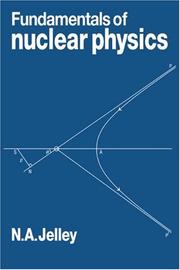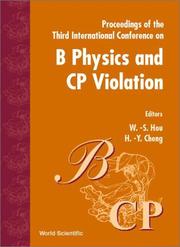| Listing 1 - 3 of 3 |
Sort by
|

ISBN: 0521269946 0521264472 9780521269940 9781139167758 9780521264471 Year: 1990 Publisher: Cambridge Cambridge University Press
Abstract | Keywords | Export | Availability | Bookmark
 Loading...
Loading...Choose an application
- Reference Manager
- EndNote
- RefWorks (Direct export to RefWorks)
Fundamentals of Nuclear Physics is a textbook on nuclear physics aimed at undergraduates in their final year, designed to give the student a thorough understanding of the principal features of nuclei, nuclear decays and nuclear reactions. The book covers the elementary concepts of the subject necessary for introductory courses and also explores more advanced topics, suitable for graduate courses. Initially several models are described and used to explain nuclear properties with many illustrative examples. Sections follow on a-, B- and y-decay, fission, thermonuclear fusion, reactions, nuclear forces and nuclear collective motion. In each case many examples are discussed, and the student should gain a thorough grounding in our current knowledge of the nucleus. The presentation is quantitative and short derivations are given in full to enable the student to make predictions about nuclear phenomena. This book will be of value to all undergraduates studying nuclear physics, as well as to first-year graduates. The level of the presentation bridges the gap between introductory undergraduate and the more advanced graduate textbooks.
Nuclear physics. --- atoomfysica --- 539.16 --- 539.17 --- 539.14 --- Radioactivity. Radioactive decay --- Nuclear reactions. Fission. Fusion. Chain reactions etc. --- Nuclei --- 539.14 Nuclei --- 539.17 Nuclear reactions. Fission. Fusion. Chain reactions etc. --- 539.16 Radioactivity. Radioactive decay --- Nuclear physics --- Atomic nuclei --- Atoms, Nuclei of --- Nucleus of the atom --- Physics --- Nuclear reactions. Fission. Fusion. Chain reactions etc --- Physique nucléaire

ISBN: 9812791876 9789812791870 9810243766 9789810243760 Year: 2000 Publisher: Singapore River Edge, NJ World Scientific
Abstract | Keywords | Export | Availability | Bookmark
 Loading...
Loading...Choose an application
- Reference Manager
- EndNote
- RefWorks (Direct export to RefWorks)
CP violation was first observed in 1964, but only in 1999 did we gain much greater experimental insight. Direct CP violation finally appeared in the form of e'/e in the K system. Indirect CP violation in B ? J/ ? K s decay, the raison d'être for construction of e + e - B factories, was first sniffed out at the proton-antiproton collider. The asymmetric B factories - BABAR at SLAC and BELLE at KEK - were completed, while the symmetric B factory at Cornell was upgraded to CLEO-III. It seems that everyone is positioning himself for the great competition on "B Physics and CP Violation", racing to
CP violation (Nuclear physics) --- Beta decay --- Meson factories --- B facilities (Nuclear physics) --- B factories (Nuclear physics) --- Facilities, Meson --- Factories, Meson --- Meson facilities --- Linear accelerators --- Beta disintegration --- Beta rays --- Decay, Beta --- Radioactive decay --- Decay
Book
ISBN: 9780470131480 0470131489 Year: 2010 Publisher: Danvers, Mass. John Wiley & Sons, Inc.
Abstract | Keywords | Export | Availability | Bookmark
 Loading...
Loading...Choose an application
- Reference Manager
- EndNote
- RefWorks (Direct export to RefWorks)
This is the resource that engineers turn to in the study of radiation detection. The fourth edition takes into account the technical developments that continue to enhance the instruments and techniques available for the detection and spectroscopy of ionizing radiation. New coverage is presented on ROC curves, micropattern gas detectors, new sensors for scintillation light, and the excess noise factor. Revised discussions are also included on TLDs and cryogenic spectrometers, radiation backgrounds, and the VME standard. Engineers will gain a strong understanding of the field with this updated book. [Publisher]
Nuclear counters --- Radiation --- Détecteurs nucléaires --- Radiométrie --- Measurement --- 539.16 --- Radioactivity. Radioactive decay --- 539.16 Radioactivity. Radioactive decay --- Détecteurs de rayonnement --- Détecteurs nucléaires --- Radiométrie --- Radiation monitoring --- Radiometry --- Electromagnetic measurements --- Nuclear detectors --- Nuclear radiation detectors --- Radiation counters --- Detectors --- Nuclear physics --- Radioactivity --- Dosimeters --- Ionization chambers --- Particle tracks (Nuclear physics) --- Period meter (Nuclear engineering) --- Instruments --- Détecteurs de rayonnement. --- Radiométrie. --- Experimental nuclear and elementary particle physics --- straling --- Monograph --- Radiation - Measurement --- Détecteurs de rayonnement. --- Radiométrie.
| Listing 1 - 3 of 3 |
Sort by
|

 Search
Search Feedback
Feedback About UniCat
About UniCat  Help
Help News
News